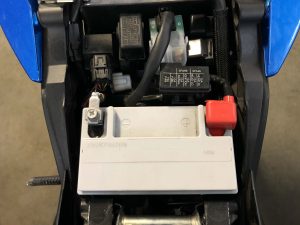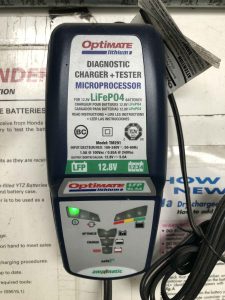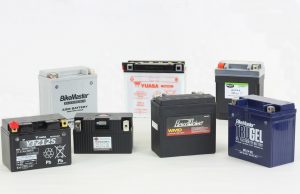How to Charge a Motorcycle Battery for the First Time
Chaparral Motorsports
|
April 16, 2019
|
Last Updated: July 3, 2020
After a long and treacherous winter, spring has finally come and the warmer weather has helped the colder parts of the country thaw out. That means it's time to rouse your motorcycle from its long winter's nap. The big question is, will your bike, or better yet your motorcycle battery, be up to the task of waking your baby from its slumber. If you thought a head of time, like several months ago when you rolled the bike into the garage at the end of fall, you made sure your battery would be good to go by hooking it up to some type of maintenance device or charger.

Before we get into battery maintenance it should be noted the most motorcycle batteries typically last about three to four years-if properly cared for. Things like extreme hot or cold weather or letting your battery sit for a long period of time without proper maintenance can have an effect on the lifespan and overall health of your battery.
Sure, if your battery drains of all its juice after sitting all winter you might be able to bring it back to life but it most likely won't be as healthy as it used to be. You may notice that it has a hard time cranking the bike over or even though it's holding a charge it's not putting out enough cranking amps to fire the bike to life, thus putting more heat and stress on your starter. So yeah it's best to keep tabs on your battery and keep it charged.
The most common battery chargers you'll come across are trickle chargers and smart chargers. A trickle charger is constantly working and slowly trickling a small charge into the battery, even when it's fully charged. A smart charger has a process of constantly monitoring the battery and ensuring the battery is always in prime form.

You may have an old school battery charger (trickle type) you bought years ago when you were having trouble with your car or truck battery and may be thinking, "I'll just use that to recharge or keep my motorcycle battery up to par." Well not all batteries are the same and as you probably noticed your car/truck battery is significantly bigger than your motorcycle battery. Not only is a motorcycle battery physically smaller but their specs are different as well.
While both are typically 12 volt batteries, a motorcycle battery has less Amperage and requires less amp charge rate. Most automotive chargers pump out 13 amps, 30 amps or even 50 amps. While technically you could use the automotive charger, if you don't keep an eye on it or leave it unattended for an extended period of time, the automotive charger will most likely over charge/fry your motorcycle battery. Some automotive chargers may have the option to switch to a lower charge rate, like 2A. However, even then you could damage your battery if you don't monitor the process since the charger will continue to work and won't automatically shut off if it's an older trickle charger type unit.
The best way to keep your battery in top shape is to use a smart charger like those offered by Battery Tender that have multiple steps in place to ensure the battery is properly charged and then continually monitors the battery to prevent undercharging/overcharging and loss of performance. Battery Tender's smart chargers go through a four step process that involves:
| Initialization | Surveying/testing the status of the battery and make sure its functioning properly |
| Bulk Charge | Charging to Full |
| Absorption Mode | Holding the battery charge voltage constant at a predetermined level, allowing the charge current amplitude to drop. The Absorption Charge Mode is complete when the battery charge current drops below a very low value, usually below 1/8 ampere. |
| Float/Maintenance Mode | Maintaining the battery voltage just slightly above where it would be if it were fully charged and sitting at rest. |
To Charge or Not to Charge

There are a variety of different types of lead acid motorcycle batteries: conventional flooded, gel, and Absorbed Glass Mat (AGM). Lithium-ion batteries have become more popular because of their smaller size and weight savings. However, when it comes to charging not all batteries are the same. While you can charge/maintain lead acid batteries with trickle chargers and smart chargers. Lithium-ion batteries require their own type of charger unless you get a smart charger that has the option to choose between lead-acid and lithium-ion charging.

When searching for a battery maintenance device you'll probably notice that just about every battery manufacture has their own trickle charger and/or smart charger. Just keep in mind that just because you have a Yuasa battery does that mean you can only use a Yuasa charger. The chargers don't discriminate based on battery brand, you just need to make sure the charger meets the requirements of your battery and is the correct type of charger for your battery type (i.e. lead-acid or lith-ion).

In the motorcycle world, Battery Tender has established a good reputation with its broad selection of smart chargers to suit a variety of needs. Some of our favorite models are the Battery Tender JR, Selectable Battery Tender JR, Waterproof Battery Tender JR. Battery Tender Plus 1.25A, and Selectable 4A Battery Tender. Check out this video to get a breakdown of the features of each unit.
Here are a few key tips for charging or maintaining your battery:
- Most chargers these days comes with quick connect 2-Pin SAE Waterproof Wire Harness Plug cables. These quick connect cables are extremely handy as they allow you to easily plug and unplug the battery from the charger while the battery is still in the bike. The cables are usually a universal fit and will work with PulseTech, OptiMate, Yuasa, BikeMaster, and Ctek battery maintainers.
- When you get your smart charger install the battery connecting side permanently to your battery terminals and route the tail end somewhere inconspicuous but where you can still easily access it when you park the bike in the garage. By doing this you'll save yourself the hassle of always having to remove the seat or side cover, and you won't have to install the battery connection every time you want to charge/maintain your battery.
- If the battery charging/maintenance unit you have doesn't have an in-line fuse on the connection cables you may want to consider plugging your unit into a surge protector to help protect your electrical system from a sudden power surge. In addition, if you aren't using a smart charger it's best practice that you remove the battery from the motorcycle. That way if the charger does cause an issue with the battery (overcharging, boiling, etc) the damage will be confined to the battery and won't harm your motorcycle or electrical system.
- If the battery side of your cable came with ring terminals ends see if you can source a SAE 2-pin lug with open ended fork terminals. Or clip the end of your ring terminals to make your own forked ends. The benefit of the fork terminals is that they are easier to mount to the battery posts than completely removing the screws to install the ring terminals. And if you have multiple bikes you can swap the plug from one battery to another much faster and easier.
- If you have your motorcycle dialed in with smart charger and a quick disconnect cable, that doesn' t mean you should't take a look at your battery every once in a while. For optimum battery life and performance take a peek under the seat (or wherever your battery is located) every once in a while and make sure it looks normal. Make sure there is no swelling or other signs of problems. Inspect the terminals and clean off any corrosion or muck that may have accumulated. If your battery terminals don't have those little rubber covers there are gels you can put on the terminals/posts to help prevent corrosion.
- Secure the battery in the battery compartment. A battery that moves around can lead to some major issues to the battery, battery terminals, or your electrical system. If your battery compartment doesn't have a brace or sturdy rubber strap you can use foam blocks as padding to secure the battery. Foam blocks are also great if your new battery is shorter or isn't the same dimensions as your old battery and you need to make up the difference.
Whether it's a new battery, a battery charger/maintenance device, or new battery terminals, Chaparral Motorsports has a wide selection of OEM and aftermarket motorcycle parts and accessories to get you up and running.
How to Charge a Motorcycle Battery for the First Time
Source: https://www.chapmoto.com/blog/2019/04/16/how-to-maintain-and-properly-charge-your-motorcycle-battery/